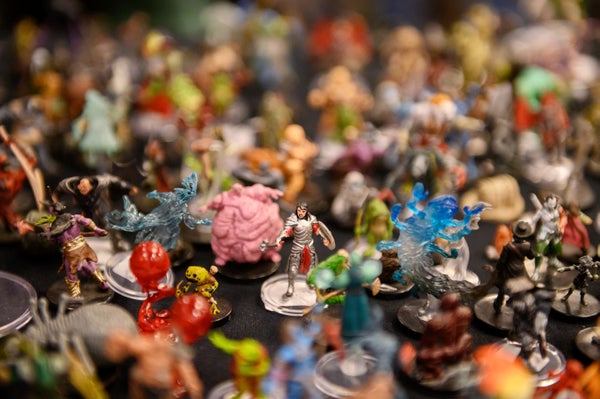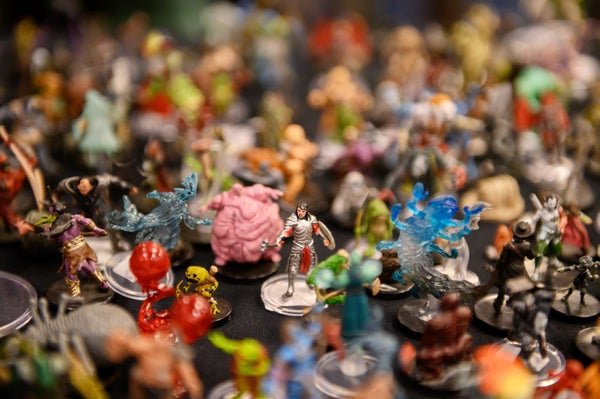Dungeons & Dragons Is Shedding ‘Race’ in Gaming. Here’s Why It Matters
The nerd culture powerhouse is rebranding its elves, dwarfs and orcs, previously referred to as races, and moving towards use of the term species

Dungeons & Dragons game figurines for sale in 2021.
Jeff Swensen/Getty Images
Dungeons & Dragons now reigns as a cultural powerhouse, the OG of tabletop role-playing. In its 50th anniversary year, the storied fantasy role-playing game is now making a long-overdue, and noteworthy, correction to its scientifically benighted treatment of race.
Attacked by religious figures for supposed demonic ties in the 1980s (part of a broader trend in that decade termed the “Satanic panic”), the game and its trappings now rule popular culture. You sit at a table with some pizza, dice and friends, and collectively engage with a story wherein you are a warrior or wizard out on a tale of heroism in a sword-and-sorcery world. What’s new is that in September, the game’s owner, Wizards of the Coast, will release a “Player’s Handbook” that changes the terminology of its character’s physiological types, previously referred to as races, and replace them with the term species.
Announced in 2022, the company’s action was motivated by a view that species is “a term that didn’t require explanation and that highlighted the fantastical nature of the game’s nonhuman options,” according to Jeremy Crawford, game director of Dungeons & Dragons.
On supporting science journalism
If you’re enjoying this article, consider supporting our award-winning journalism by subscribing. By purchasing a subscription you are helping to ensure the future of impactful stories about the discoveries and ideas shaping our world today.
Wizards of the Coast should be congratulated for the move, both for the company’s stated reasons and, scientifically, as a correction from the long-running error of describing species as races. Kids playing a fun game will no longer pick up a botched, eugenical notion of race alongside their 20-sided dice.
Some players welcomed the change and the rationale behind the shift to species. However, others felt insulted, arguing Wizards of the Coast was giving into a “woke” mentality, fearful of invoking the word race. Still others appreciated the move but felt it didn’t go far enough. They recommended the removal of other material that could be deemed offensive. This last group is highly critical of the biological essentialism, parroting scientific and evolutionary language to explain marked social and cultural differences between groups, that comes with the use of terms like race to distinguish between humans and others like elves, dwarves and orcs, particularly because of stereotyped real-world associations made at times to these fantasy species.
As a social scientist who studies male-dominated subcultures, I have done research that put me in spaces where I delved into reactions to issues of race in gaming. A key question is this: Given how charged the term race has been, why would games use it to discuss differences that have nothing to do with the way we traditionally use the word? Dungeons & Dragons is not the only game to use the term in this way; so have many other digital and analog fantasy offerings. But the celebrated game, created by Gary Gygax and Dave Arneson in 1973, arguably set the standard that these others have followed. Gygax and Arneson leaned heavily on popular fiction and folklore to construct their game world, and links to fantasy author J.R.R. Tolkien’s works, which were first penned in an age of colonial racism, are undeniable. In his Lord of the Rings trilogy, Tolkien commonly used the word race to characterize differences among humans, elves, hobbits—all of the societies that populated his novels. Because this was familiar territory for so-called sword-and-sorcery fans, the creators of Dungeons & Dragons simply co-opted it, as it would create a recognizable point of reference for potential gamers.
So biological essentialism ran deep in the game. In its earliest versions, the authors distinguished between humans and other groups, collectively called “demihumans.” Notably, players who chose to be dwarves, elves, halflings or other demihumans had limits that humans did not have. They were lesser beings. They could only have certain professions in the game (referred to as classes), could only progress so far, and had built-in limitations (for example, sturdy but somewhat slow and dour dwarves had constitution advantages, but limits on their dexterity and charisma). Further, all demihumans had some form of seeing in the dark, which marked them as something in between humans and animals.
The most often cited element of biological determinism in the early game, however, was a table created in the first edition of the Advanced Dungeons & Dragons game that dictated which demihuman cultures would get along easily or have a natural dislike. Elves and dwarves had antipathy, by fiat. Neither liked half-orcs. And gnomes for some reason only tolerated half-elves.
This was often discussed in the same breath of “evil races,” as different species were assigned an overall cultural moral stance, with some—such as orcs—deemed inherently evil. Particularly since the influx of new fans with the fourth edition of Dungeons & Dragons, these ideas were roundly criticized by scholars and others as reinforcing a sense of “nature not nurture” in terms of racism, discrimination and morality, echoing human genetics’ origins in white supremacy, marking some groups as inherently “bad.” Scholars such as Benjamin Carpenter of the University of East Anglia have noted that the races labeled as “evil” had analogues that were sometimes associated with real-world racial and ethnic minority groups, essentially smuggling old prejudices and stereotypes through a game.
Throughout the years, different editions of Dungeons & Dragons have reconsidered some of these components of essentialism. Level limitations for different racial groups were removed along with gaming stat limitations on nonhuman species, providing different systems to explain their advantages and disadvantages. Wizards of the Coast has reworked the game’s system of morality, called alignment, in recent editions, and eliminated the concept of evil races. The fifth edition and 2024 modification reintroduced species like orcs and dark elves in a manner that pushes back on their historical characterizations as evil cultures and inherently “bad” species. Social media voices, such as the Slovenly Trulls podcast, are discussing other game components that might need to be reconsidered, like misogyny and discrimination.
However, as someone who studies social structure, I can say that, in the gaming world, all this is a first step in a marathon. Significant numbers of role-playing game systems persist with race to distinguish between “humans” and “others.” Some gamers still loudly protest any change and continue to use race as it was in the past.
Nostalgia and persistence are powerful; they both have a hand in the continued success of Dungeons & Dragons. But they also hamper the possibility of change, even for the right reasons. Sometimes even fantasy games should look to a brighter future, rather than a glittering past.
This is an opinion and analysis article, and the views expressed by the author or authors are not necessarily those of Scientific American.



